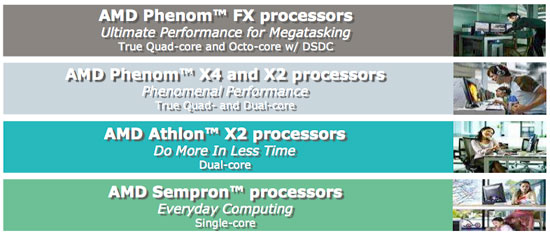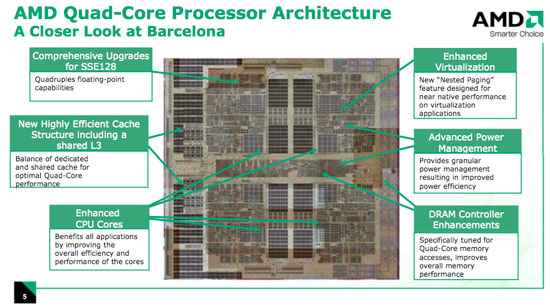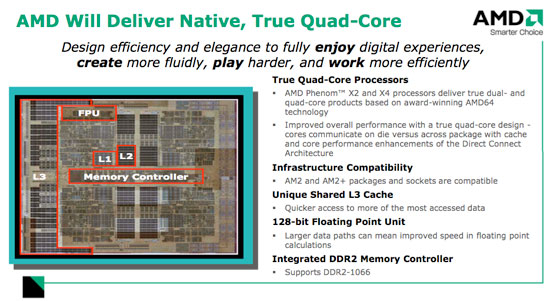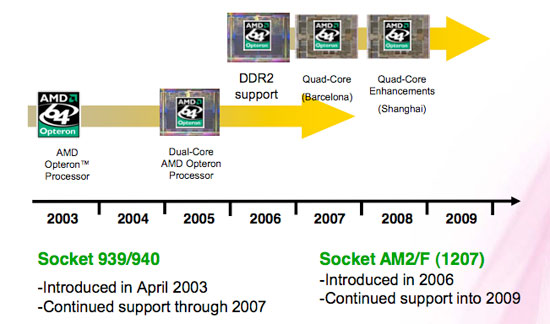
Original Link: https://www.anandtech.com/show/2230
We've been calling it Barcelona or Agena for several months now, but AMD has finally named its next-generation desktop processors; and the new name is Phenom. Not quite as odd sounding as the Athlon was when it was launched, but still very much an AMD product name. The new AMD line up is as follows:

At the top of the product lineup we have the Phenom FX processors (codenamed Agena FX). These processors will be quad-core only and run at the highest clock speeds in AMD's lineup, much like the current Athlon 64 FX. At the Quad FX introduction, AMD indicated that FX processors would be Socket-1207 only, simplifying its product lineup. Unfortunately, AMD has once again reversed its decision and Phenom FX processors will be available in both Socket-1207 and Socket-AM2 flavors.
The Phenom X4 and X2 processors are the sensible versions of the Phenom, these are the ones we will most likely be recommending out of AMD's lineup if history holds true. The X4 and X2 will be Socket-AM2/AM2+ only and are 100% backwards compatible with current AM2 motherboards.
The current Athlon 64 X2 has been renamed to the Athlon X2; given that both AMD and Intel offer 64-bit processors, dropping the 64 from the name makes sense. At the bottom of the list is AMD's Sempron, which is the only single core brand in the product lineup.
AMD hasn't updated us on other details for Phenom, which is a bit odd given how much more forthcoming AMD has been privately about other aspects of its microprocessor plans. Either AMD is doing its best to hide a rough ramp of Phenom or it is sitting on a very powerful weapon to combat Intel with, and we can't get any indication of which it is.

Architecturally, we've already said all there is to say about Phenom. The core is an evolution of the current K8 architecture, with a lot of attention placed on SSE performance and other general IPC enhancements. Phenom will also be the first monolithic quad-core x86 processor to hit the market, which does have some technical advantages but we're not sold on whether or not we'll see any tangible real world benefits over Intel's multiple die approach (e.g. we didn't see any benefit with monolithic dual core vs. multi-die dual core).

Phenom will work in current Socket-AM2/Socket-1207 motherboards with a BIOS update, but it loses the ability to run its Northbridge and CPU cores at separate voltages/clock frequencies. If you buy a new Socket-AM2+/Socket-1207+ motherboard, then the CPU cores and Northbridge can run at separate voltages/frequencies. The benefit of doing this is not only power savings, but AMD has indicated that it can actually run the Northbridge faster than the CPU cores (by 200 - 400MHz) which will improve performance. The L3 cache happens to run on the same voltage plane and at the same frequency as the Northbridge, compounding the performance benefits of using a new "plus-socket" motherboard (Socket-AM2+/Socket-1207+).

The memory hierarchy of Phenom has been improved over the current K8 architecture; there's now an L3 cache shared by all cores and a higher efficiency DDR2 memory controller, which is needed given that there are now more cores vying for the same amount of bandwidth.
AMD has officially confirmed that Phenom will support up to DDR2-1066, reasserting AMD's commitment to the memory technology it switched to a year ago.
What about DDR3?
We asked AMD's Phil Hester when he expects to see DDR3 make sense for the desktop, and he gave us an unusually candid answer. According to Hester, it won't be until late 2008 or early 2009 that DDR3 will make economic sense to move to. Given that Phenom will be DDR2 from the start, it looks like AMD's transition to DDR3 will be much like its transition to DDR2: it will complete well after Intel has made the move.
AMD views Intel's constant switching of memory technologies as adopting new technology for the sake of technology, while it prefers to respond directly to its customers' needs. Intel's argument has always been that it needs to make these transitions early to prepare the entire market for them. Clearly we need both approaches; we need a company to take the hit and move the market to a new memory technology so that volumes can ramp up enough to drive the price down. At the same time we need a company like AMD to give those in the know an alternative in the interim, otherwise we would all be paying a lot of money for a new memory technology that today offers no performance improvement.
If AMD moves to DDR3 in the late-2008/2009 timeframe it's unclear as to whether or not we'll need a new processor socket. AMD's current roadmap shows the second generation Phenom core (Shanghai) due out in 2008 but still on Socket-AM2+/1207+. It's quite possible that AMD will introduce another socket in late 2008 (AM3?) that will offer DDR3 support to begin its transition to the new memory technology.
Shanghai : Barcelona :: Penryn : Conroe?
AMD has quietly introduced Shanghai into its processor roadmaps, and it's the successor to the Barcelona core. Little is publicly known about Shanghai but you can expect the newer, open AMD to begin revealing details in a controlled manner; the days of a totally silent AMD are over.

Based on AMD's roadmap, Shanghai will be socket compatible with Barcelona and it is listed as an enhanced version of the Barcelona core. Given that AMD is expected to be at 45nm in the second half of 2008, we'd expect Shanghai to be to Barcelona what Penryn is to Conroe. Unfortunately, Barcelona will most likely compete with Penryn and Shanghai will go head to head with Nehalem, and we have absolutely no indication of how those battles will end up at this point.
Final Words
Today's announcement is more marketing than substance, but it brings us one step closer to what we want: Phenom performance results. Any noise from AMD at this point is better than nothing. Can you guess its next move? It may be more difficult to predict than you'd think...







